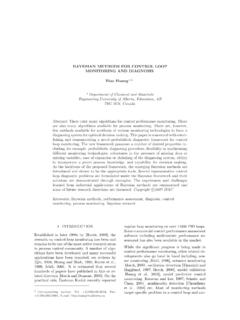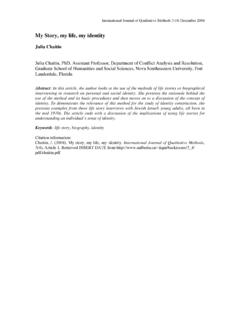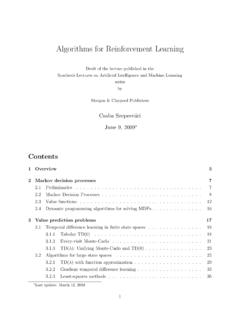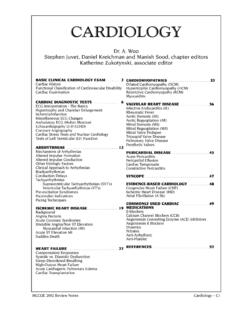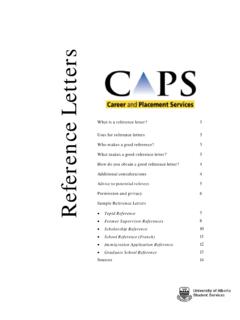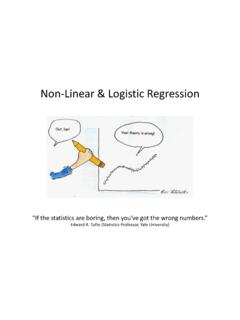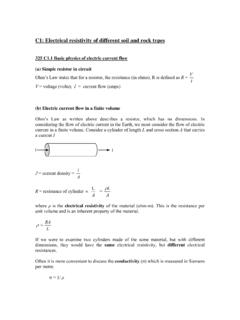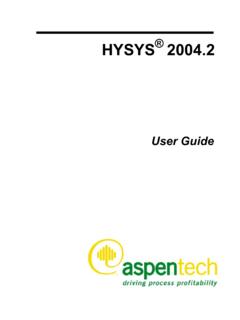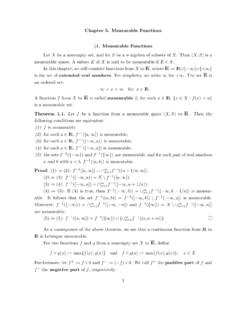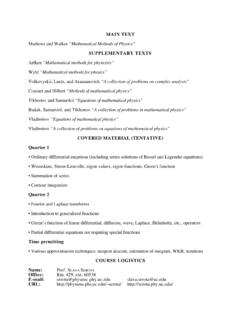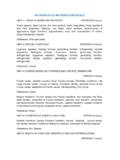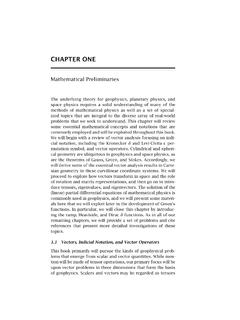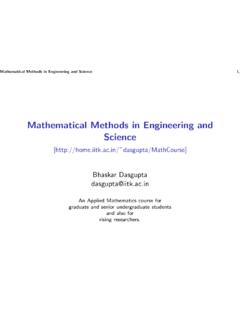Transcription of MATHEMATICAL METHODS OF PHYSICS I – 2014
1 MATHEMATICAL METHODS OF PHYSICS I 2014 THOMAS CREUTZIGABSTRACT. These are lecture notes in progress for Ma Ph 451 MATHEMATICAL PHYSICS I. Thelecture starts with a brief discussion of linear algebra, Hilbert spaces and classical orthogonalpolynomials. Then as an instructive example the Lie groupSU(2)and its Hilbert space of squareintegrable functions will be discussed in detail. The focus of the second part of the lecturewill then be on Lie groups in general, their Lie algebras and its representation theory. Guidingexamples are bothsl(2;R)andsl(3;R). Finally, we discuss how Lie groups, their harmonicanalysis and especially Lie algebras appear in the example of bosonic 23, CREUTZIGCONTENTS1. Introduction42. Linear Vector Linear Transformations and Eigenvectors and Solutions173.
2 Hilbert The definition of a Hilbert Square integrable Classical orthogonal Gegenbauer polynomials and hypergeometric Hermite Solutions304. Harmonic Fourier Harmonic analysis on the Lie groupU(1) Harmonic analysis Solutions495. Lie The Haar Lie subgroups ofGL(n,C) Left-Invariant vector Example of a Lie supergroup586. Lie The Casimir element of a Jordan Root Space Finite-dimensional irreducible representations ofsl(2;R) Representation Highest-weight representations ofsl(3;R) Solutions777. The bosonic The free boson compactified on a The Virasoro Lattice CFT83MA PH Fermionic BRST quantization of the bosonic string848. Possible Exam Questions85 References874T CREUTZIG1.
3 INTRODUCTIONWe will cover subjects of interest in MATHEMATICAL PHYSICS . Lie theory is a fascinating areaof MATHEMATICAL PHYSICS with various applications in both areas. So the focus of this lecturewill be on Lie theory. Lie groups are smooth manifolds that at the same time are groups. Theyhave been introduced by Sophus Lie. In studying Lie groups it turns out that it is much simplerto consider infinitesimal transformations. These transformations have an algebraic structurecalled Lie algebra. Lie algebras and Lie groups are important as they appear as the symme-tries of physical systems. This leads to a variety of connections of interesting modern topicsof MATHEMATICAL PHYSICS . Both Lie groups and Lie algebras are often best visualized using ma-trices. Examples that are familiar to most physicists are the Heisenberg Lie group and the Liegroup of the standard model of particle three-dimensional Heisenberg group isH= 1a b0 1c0 0 1 a,b,c R.
4 So it is a subgroup of invertible 3 3 matrices. Its Lie algebrahon the other hand is spannedbyh=span p= 0 1 00 0 00 0 0 ,q= 0 0 00 0 10 0 0 ,z= 0 0 10 0 00 0 0 Lie group and Lie algebra are related by the exponential mapexp(X) = n=0 Xnn! Hfor allX h.(You can check this doing explicit matrix multiplication) The commutator of matrices definesan algebra structure onh,[X,Y] =XY Y the appropriate matrix multiplication one finds that these commutators or Lie brack-ets are zero, except for[p,q] = this is exactly the Heisenberg Lie algebra of quantum mechanics under the identificationp= i hddx,q=x,z= i Lie group of the standard model isU(1) SU(2) SU(3). This is the product of a one-dimensional Lie groupU(1), a three-dimensional Lie groupSU(2)and an eight-dimensionaloneSU(3). The standard model is a gauge theory, and each generator of the Lie group hasan associated gauge boson.
5 The electroweak interaction is described byU(1) SU(2), andtheU(1)-gauge particle is the photon, while the ones forSU(2)are calledW andZgaugebosons. Quantum chromodynamics is associated to theSU(3)and the eight gauge bosons arecalled gluons. Quarks and leptons then come in colors, with spins and electric charge. Thesequantities encode how the particles behave under the action of the gauge group, that is the LiegroupU(1) SU(2) SU(3). A mathematician would call these quantities weights, and therepresentation theory of the underlying Lie algebra would tell him how the gauge group initial purpose of studying Lie theory was the understanding of certain differential equa-tions. If you look back to your quantum mechanics course, the Heisenberg algebra and also theMA PH 4515 Lie algebra of infinitesimal rotations describing spin and angular momentun, were used to solvethe Schr odinger equation, a differential equation.
6 In general, the representation theory of Liealgebras is a great aide in simplifying certain second order differential are more modern connections between Lie theory, PHYSICS and mathematics. Stringtheory is a quantum theory of strings and not of point-like particles. It s inital motivation wasthe search for a quantum theory that both incorporates particle PHYSICS and gravity. The frame-work of string theory uses a variety of mathematics, ranging from geometry, topology, algebraand number theory. But Lie theory is always central, simply since a Lie group or Lie alge-bra of some kind will always appear as symmetry of the theory in questuion. Moreover, theworld-sheet theory of a string is a two-dimensional conformal field theory. Local conformaltransformations in two-dimensions generate an infintie-dimenisonal algebra, the Witt central extension is called the Virasoro algebra.
7 This is an infinite-dimensional Lie algebraand it is contained in the symmetry algebra of every world-sheet theory of every string. Onlydue to Lie theory the conformal field theory can be exactly solved. This is extremely special;exactly solvable quantum field theories are very rare. Both conformal field theory and stringtheory have lead to an tremendous progress in pure mathematics. I plan to tell you a little bitabout the bosonic string, infinite-dimensional Lie algebras and the monstrous moonshine at theend of the lecture as an interesting application/generalization of what you have learnt. Thismonstrous moonshine is a surprising connection between modular functions (number theory)and finite groups. But this is by far not the only progress in mathematics due to PHYSICS re-lated to Lie theory. Another one is three-dimensional tolpological quantum field theories andinvariants of knots.
8 You surely know what a knot is, and you can probably imagine that it isdifficult to describe arbitrary knots on some three-manifold. However, Witten found that thereis a topological field theory, called Chern Simons theory, that can be used to understand theproblem of describing knots. If you want to describe a knot in some three-manifoldM, youdonot really care about the size of the knot. So you need a theory that is metric independent todescribe them, the Chern Simons theory. LetGbe a compact Lie group, the gauge group. Youshould think of this Lie group as a subgroup of invertiblen nmatrices. The Chern-Simonsaction is then built out of Lie group valued (that is matrix valued) gauge connectionsA,S=k4 Mtr(A dA+23A A A).More correctly,Ais a matrix in some representationRofG. tr denotes the trace, that is the sumover the diagonal entries, of the matrix.
9 To each knotC, one can assosiate a Wilson loopW(C,R) =tr(Pexp( CA))as the trace of the path ordered exponential of the integral along the knot of the gauge connec-tion. Expectation values of these Wilson loops are then invariants of knots that are naturallyassociated to representations of compact Lie groups. This PHYSICS description finally allowedto characterize knots in an efficient and treatable manner. Both Edward Witten and VaughanJones are the pioneers in this area, and both of them received the fields medal. Chern Simonstheory is a topological quantum field theory. However, if the manifoldMha a boundary, thenits boundary degrees of freedoms are described by a two-dimensional conformal quantum fieldtheory, the Wess Zumino Novikov Witten model of the Lie groupG. The action of this the-ory looks similar as the Chern Simons action, just that the gauge connection is replaced bythe Maurer-Cartan one form.
10 This is the invariant Lie algebra valued one-form of a Lie CREUTZIGThe conformal field theory is completely described by the representation theory of the affiniza-tion of the Lie algebra ofG. Turning things around, another huge success of the last decadesin MATHEMATICAL PHYSICS was the interaction between infinite-dimensional Lie algebras (Kac-Moody algebras), conformal field theory and modular forms. Note, that Robert Moody hasbeen a professor of the University of Alberta. The success is due to the very surprising fact, thatthe representation theory of the Lie algebra is guided by modular forms, that is by functionsthat behave nicely under the action of the M obius groupSL(2;Z)action(a bc d) =a +bc + , for a physicists this is less of a surprise. The point being that axioms of two-dimensional conformal field theory tell us, that the representation category of the field theory isa modular one.
